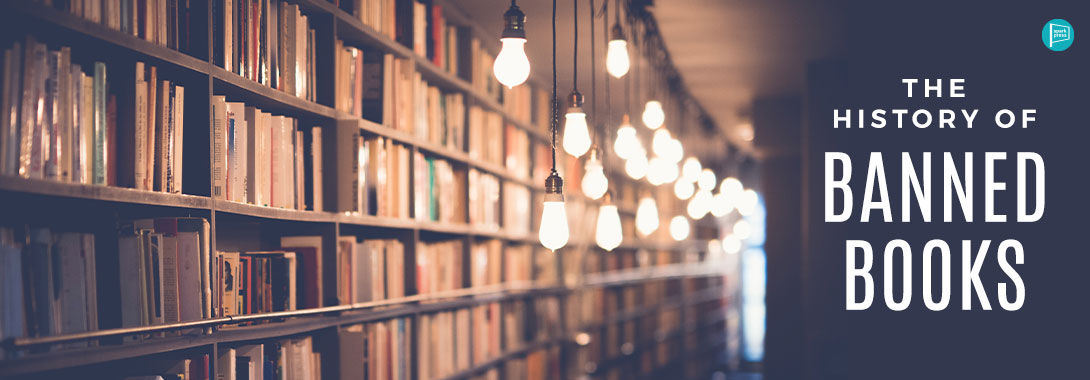
With Banned Books Week coming up this month, it’s a time to commemorate our freedom to read. Book banning and censorship has long been a part of our history. Dating all the way back to ancient times, cases of burning books have occurred all over the world. Generally, books deemed inappropriate by government officials or organizations—due to anything ranging from sexual, racial, immoral, blasphemous, violent, or political bias themes—are removed from libraries and school lists; even banned entirely from distribution.
With new books being added to the list each year, the concept of banning is well-known today. However, what may not be well known is the history of banned books in the United States. It’s one of the most widespread forms of censorship today. But when did book banning begin?
Let’s take a look at the early history of book banning.
The first banned book in America
Book burning is a long-held practice throughout the world. The earliest incident dates all the way back to the Huang Dynasty in China. The Emperor burned all books of the past—and even scholars—in order to erase its history. Book burnings continued to make way through history in Egypt when Julius Caesar burned down the great Library of Alexandria. Then mass bonfires in Italy became a large movement to erase all vanities.
In 1650, William Pynchon’s The Meritorious Price of our Redemption sparked outrage in the New England colonies. This pamphlet refuted Puritan Doctrine, and the Massachusetts Bay colony condemned the book and had it publicly burned at the Boston Marketplace. It is considered the first book to be banned and burned in the United States. Shortly after, William Pynchon was banished back to England.
The Comstock Law and it’s Effect on Banning
In 1873, Congress passed the Comstock Law. This act condemned the trade of obscene literature and articles for immoral use. The ban targeted works that contained sexual content, including medical journals offering education on human anatomy. Similarly, anti-obscenity laws were created in other states. Famous books banned under the law include Ulysses by James Joyce and The Canterbury Tales by Chaucer.
Ulysses was published in 1918 by The Little Review. Each issue contained an episode from the travels of Leopold Bloom through Dublin. The postal office seized the magazine after publishing the Nausicaa episode in which the main character fantasized about a young woman. The issues were subsequently burned, and the book was soon banned under the Comstock Law. Similarly, The Canterbury Tales was banned for its sexual content and use of swearing.
The Modernist Movement and Famous Banned Books
Book banning became widespread in the late 18th century, continuing into the early 19th century, until writers began to fight back with the explosion of the modernist movement. Modernist writers broke the boundaries of what acceptable literature was and wrote about topics that were once considered taboo. Those included thoughts about the first World War, the development of industrial societies, the rejection of religion, and the breaking of social traditions.
Famous writers who emerged during this movement included Theodore Dreiser, Ernest Hemingway, and F. Scott Fitzgerald. Despite revolutionizing modern literature, many of their works were banned. Theodore Dreiser’s book Sister Carrie, published in 1900, reflected views of naturalism during a period of urbanization. However, the book was banned in 1916 for its immorality. In 1929, Hemingway published A Farewell to Arms, which depicted the gruesome account of WWI. So, that book was banned in that same year for crude matter.
Banned Books Week
During the 1970’s, book banning reached its all time high. Complaints were made each year with more and more books being banned from libraries. With a surge in book censorship, Banned Books Week was created in 1982. The purpose of the movement was to bring awareness and remove restrictions from books. Banned Books Week aims to build a community of acceptance where all forms of art are accepted despite their unpopular ideas or themes. The movement is still going strong today and has gained popularity in recent years by overturning censorship on books. Each year they create a list of the top books that were banned to gain recognition.
As literature evolves, books that were once banned have had their status overturned. The freedom to write and express ideas has become widely accepted and continues to grow as new forms of literature come out today. Though book banning still exists, it’s become less frequent due to acceptance of creative expression.
What are some of your favorite banned books’ stories?
Ready to see your book in print? Explore our publishing packages here.
Sources:
Banned Books Week. (n.d.). Retrieved from https://bannedbooksweek.org
The Best of Banned Books. (2017, March 3). Retrieved from https://granta.com/best-banned-books
Theodore Dreiser’s Sister Carrie and the Urbanization of Chicago. (n.d.). Retrieved from https://dp.la/primary-source-sets/theodore-dreiser-s-sister-carrie-and-the-urbanization-of-chicago
William Pynchon, The Meritorious Price of Our Redemption (1650). (n.d.). Retrieved from http://clements.umich.edu/exhibits/online/bannedbooks/entry5.html

Great post!
Wonderful review and insightfully written
[…] banning has a long history, but it reached an all-time high in the 1970s. Communities were constantly fielding complaints about books for a variety of reasons – violence, […]
does anyone know when “unsuited for age group,” was added as a reason for challenging/banning a book?